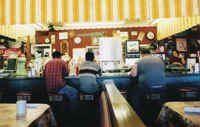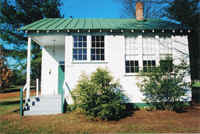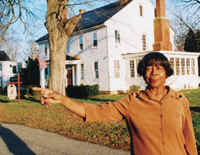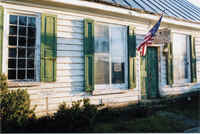
Download
in PDF Format
In
1982 when author Ralph Emmett Fall wrote Hidden Village, a history of Port
Royal, Virginia, he observed, �Most travelers along the highways pass by
Port Royal � [it] has been a village incognito, physically hidden from
view.�
|

As
you near the town of Port Royal, the distinctive yellow roof of
Horne's Restaurant & Gift shop appears. |
Nearing town, a
yellow-roofed Horne�s Restaurant appears. As the town limits come into
view, a smattering of buildings and small businesses dots the horizon
along Main Street/Route 301. But much of the actual town, including
historic homes dating to the 1700s on a grid of streets parallel to the
highway, remains hidden from travelers� views.
Settled in 1652, Port
Royal, nestled along the banks of the Rappahannock River in
|

Lunchtime
customers of Horne's can enjoy vintage fountain-style dining or a
spacious booth. |
Caroline
County, is about 50 miles north of Richmond. Once a bustling colonial
river port, today the sleepy community of 204 people may be on the cusp of
change.
According to Calvin
Taylor, chairman of the Caroline County Board of Supervisors whose
district includes Port Royal, among the changes is Haymount, a planned
mixed-use community under development less than 10 miles from Port Royal.
Haymount encompasses 1,600 acres and will add 4,000 homes to the area.
|

The
Old Port Royal School, a one-room schoolhouse in the days of
segregation, operated from 1924-1959. |
�Quite a few of the
people in town have lived there 20-plus years, and there are not a lot of
new people within the town limits. But as Haymount comes on line, you�ll
see new people come � the biggest challenge is maintaining the rural
character, and at the same time providing the services citizens need,�
Taylor says.
Cleopatra Coleman
believes �reclaiming and preserving� the town�s historic heritage is
Port Royal�s biggest challenge. The first president of Historic Port
Royal, Inc., Coleman, a retired teacher and social worker and Caroline
native, is an energetic ambassador for town history. She and her husband
live in the Bowie House, a riverfront frame home built in 1740.
Coleman points out to
a visitor some of the town�s treasures. They include Fox Tavern (1759),
where George Washington lodged overnight in 1760. The Brockenbrough-Peyton
House, one of the town�s earliest mansions, is where John Wilkes Booth
stopped April 24, 1865, 10 days after he assassinated President Abraham
Lincoln, before seeking refuge at nearby Garrett Farm, where he was killed
by pursuing Union soldiers two days later.
|

Cleopatra
Coleman of Historic Port Royal, Inc., points out some of the
town's many historic buildings. Coleman is a walking encyclopedia
of Port Royal structures. Behind her is Fox Hall Tavern, where
George Washington once lodged. |
�Life in Port Royal
is returning to my roots. I have a passion for history, and this is a
historic place. So it�s a good match,� Coleman explains.
�History is not all
beautiful and positive,� she adds, acknowledging the fact that
African-Americans who went before her endured slavery. �I can take a
certain pride because my people, though under the tongue and the lash,
built a lot of this [history].�
Historic Port Royal,
Inc., volunteers have erected historical signage throughout the town,
acquired several historic properties, and reprinted Fall�s Hidden
Village book, among other accomplishments.
One of the town�s
unique structures sits on Route 301 next to its owner, Union Bank &
Trust. Old Port Royal School, a one-room schoolhouse for black children in
the days of segregation, operated from 1924-1959. Volunteers restored the
building, and in May and October, the school hosts a �living history�
program for schoolchildren.
�One teacher taught
seven grades in that schoolhouse � I teach the class as children would
have been taught in those years,� Coleman explains.
Mamie Dickerson, 92,
a Caroline native, moved to Port Royal in 1929 when she married. Dickerson
says her children attended the one-room schoolhouse.
�The teacher,
Hortense Rich, taught several grades � everything was different then. We
had outdoor toilets and pumped water from the well,� she recalls. �To
give my kids a bath, I had to heat water on an old wood-burning cook stove
and pour it in the tub. My kids studied by lamplight. There were no
streetlights; you took a lantern to go outside [at night]. I think we got
electricity around 1940. It was a hard life � I wonder sometimes how we
made it.�
Herb Posner, Port
Royal�s mayor, originally from New Jersey, says he ended up in Port
Royal in 1976 almost by accident. After years as a sales representative,
his plans to move to the Caribbean were interrupted when his father became
ill. While tending to his boat, moored in Deltaville, he met a plant
nursery owner and wound up buying his excess inventory. The owner
suggested Port Royal might be a good place to sell plants. Posner rented
an empty store, bought a house in town, married, and settled into Port
Royal life.
�It was a big
adjustment at first,� he says. �But I spent two years aboard ship in
the Coast Guard, so I�m adaptable. We have a good mix of people here and
people get along with each other.
�We don�t have
any room for expansion in town, although we have open land near the
town,� Posner says of future development. �The business district is on
both sides of 301 and zoning is for light commercial, so I imagine the
town will stay pretty much the way it is. We have few resources here in
terms of doctors or shopping, and our closest grocery stores are in
Bowling Green or across the river in King George.�
As mayor, he says the
town is working to improve its water system, fueled by two active wells,
and is upgrading street lighting.
|

Some
of the town's buildings have undergone careful restoration, while
others await their turn for a facelift. |
Caroline natives Lisa
Burch and her mother, Joyce Carter, a 14-year catering veteran, own The
Tavern of Port Royal, the only restaurant within town limits. Housed in a
historic house on Main Street/301, the duo bought the vacant circa-1852
building and spent over $100,000 renovating it before opening in 2002.
A cream-and-mauve colonial motif, fireside dining, and candlelit
tables provide a welcoming ambiance. Burch emphasizes fresh food, noting
that everything is made from scratch.
�With so much
development coming our way, I�m concerned the historical charm of Port
Royal will fade,� Burch admits. �But it will be better, business-wise.
I hope they [newcomers] will appreciate our unique character.� She
adds, �I know my neighbors and I look out my [upstairs] window and see
the river.
�The catering
business has exceeded our expectations. The restaurant is challenging �
I work 100-110 hours a week � but it has kicked off really well.�
|

Tommy
Morse is a co-owner of Horne's. |
Tommy Morse, co-owner
of Horne�s Restaurant & Gift Shop for 15 years, says the majority of
his customers are travelers, although he has some locals who are
�regulars.� �One guy eats here three times
a day,� he notes.
With milkshakes
created by antique multi-mixers, booths and fountain-style dining, and an
eclectic gift shop, Horne�s is something of a time capsule with its own
colorful history. The original Mr. Horne sold candy to Stuckey�s, a
chain of eateries famous in the South; when Stuckey�s opted to make
their own candy, Horne opened his own chain. But with the construction of
I-95 and similar superhighways, customer traffic declined and Horne�s
ceased to exist as a chain. But some Horne�s locations, like Port
Royal�s, remain open under independent ownership.
�We�ve survived
because of our location. We have people who have been coming here for
years,� Morse says.
Morse says many are
attracted to the restaurant�s nostalgic theme, while others enjoy
browsing the gift shop. Open seven days a week, 24 hours a day, Horne�s
also sells gasoline and diesel fuel, and employs 35 people.
Jessie Wheeler is a
maintenance man for Horne�s who says he has worked there since 1967. A
long-time resident, he describes Port Royal as a nice, close-knit
community. �There are people who have lived
here for generations. You still have a lot of farming and logging in the
area,� Wheeler says.
When asked what has
kept him here, he replies, �I don�t like the city.�
Phyllis Carpenter, a
retired teacher, and her husband Bill, opened Edmont Bed & Breakfast
in January 2004 just outside town in a Colonial-revival home built in 1976
by her parents. Edmont offers guest rooms filled
with antiques and reproductions.
�I love to cook and
I love to entertain,� Carpenter says of the decision to open Edmont.
�We�re pleased with our first year in business, and we�ve met some
very interesting people.�
Mid-Atlantic
Laboratories, a firm providing environmental water testing, located its
eight-employee lab in Port Royal about five years ago. Executive director
Dwight Storke, Ph.D., says a large vacant building that could accommodate
lab machinery and a town that �worked very nicely with us� combined to
cement the move. Formerly with The National Park Service, Storke also
pastors the town�s Memorial Baptist Church.
�We weren�t
encumbered by the strict [business] regulations you find in cities,�
Storke says of business life in Port Royal. He describes his congregation
as �close-knit folks who really care about each other.�
�It�s such a
pristine area [here] � it needs some upkeep, but it has so many little
jewels,� he observes.
With a waterfront
location only 30 minutes from Fredericksburg and surrounded by encroaching
development, Port Royal seems destined for change. But as Burch says,
�The upside of [coming] development is people will find out about us.�
Coleman says,
�You�ve got to have some change.
A
community is a living, thriving thing. I think this town can be energized
by newcomers who bring in fresh outlooks and resources. I�m optimistic
about the future of Port Royal.�